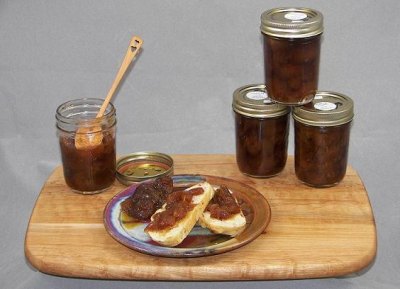If you can protect your ripening fruit from hungry birds and squirrels (a fish net over the tree helps) and you don’t get five solid days of rain that makes them rot on the branches, then you’ll have a nice mess of figs for eating fresh and putting up for later.
Figs (genus Ficus) are actually strange and fascinating fruits, cultivated since antiquity. The flower of a fig tree is on the inside of a fleshy container – the fruit bud – and, at least for the commonly-grown garden figs we have on Ocracoke, it doesn’t require pollination. The fig trees make fig fruits by parthenocarpy (a fancy word for “virgin fruit”) and, according to sources on Google, could have been the first domesticated plant of the Neolithic Revolution – a thousand years before people started farming grains. We know for sure that figs have been found in archaeological digs that date back to 11,000 BC in their native land of the Jordan River valley. From there, the species spread throughout the Mideast and Mediterranean. They are rugged trees that thrive in sandy soil and survive being regularly doused with salt water.
Chester Lynn, Ocracoke native, gardening expert, and owner of Annabelle’s Antiques and Florist, cites proof that fig trees have been on Ocracoke since colonial settlers brought them here, probably in the early 1700’s.
“The oldest record is a letter from John Wallace, who owned Shell Castle Island in colonial times, telling his friend that he won’t be able to get to Portsmouth until fig season is over,” Chester said in an OPS Porch Talk on local figs. “That shows the figs were already established and bearing fruit.”
Chester remembers a time when, “If it was August, you could smell figs cooking as you walked down the street.”
Every home had a fig tree back then, and they were traditionally planted in the back yard near a chicken pen or fish cleaning bench. Chester explained the common practice of piling clam and oyster shells around the base of a fig tree.
“Some think it’s lime from the shells that help the tree bear,” he said. “But it’s not the lime. My grandfather used to sit and open clams and oysters and chuck the shells under the tree. It was the juice from the seafood that was so good for the tree. They’d bury fish parts around the base, too.”
Ocracoke ladies poured their dishwater on fig trees, and also fed the trees with the “pot liquor” leftover from cooking. Some folks rigged their sinks to drain near the fig trees, ensuring the tree would get plenty of water and nutrients.
Taking care of the fig tree was important – if it didn’t bear fruit, you couldn’t make fig preserves – and everybody wanted fig preserves.
“To put up figs everybody used give-or-take the same recipe,” Chester said. “But every Ocracoke lady had some idea about what was best.”
Some added coconut or cinnamon to their preserves, thought that’s not so common today. But, Chester said, “Everybody added a slice of lime.”

Fig preserves are delicious on toast or a biscuit, and there are some creative ways to serve them (try them with rosemary chevre – yum!), but by far the most popular on Ocracoke is to bake them into a fig cake. Chester credits the late Margaret Garrish with inventing the first Ocracoke fig cake in the 1950’s.
According to legend, Margaret took a recipe for date cake, substituted fig preserves for the dates, and – voila! – history was made. Before that, figs were used to make preserves and syrup. A pre-50’s fig cake would have been a basic yellow layer cake with fig preserves between the layers, not the dense, dark, moist concoction we enjoy today.
Chester has identified at least nine varieties of fig trees on Ocracoke. There are honey figs, yellow figs and lemon figs, Celeste figs, and purple figs, pound figs, brown turkey figs, and sugar figs. They differ in size (1 ½” to 3” long) and color (shades of brown, yellow, blue, and purple) and shape (some are round, while others are tear-shaped), but all of them are sweet and delicious.
Although Chester laments that there aren’t as many fig trees on Ocracoke today as there were in his boyhood, their popularity is making a comeback. Local, organic produce is trendy and popular with visitors and locals alike. Foodies appreciate traditional culture and cuisine. Chester sells several varieties of Ocracoke figs (propagated by layering or rooting) at Annabelle’s, and many people take one home as an edible souvenir of Ocracoke.
If you are lucky and have an abundance of figs, here’s what to do: follow Mildred O'Neal's recipe from the old Hoi Toiders' Recipes And Remembrances Cookbook:
Fig Preserves
10 quarts of figs
5 pounds of sugar
Wash figs and let stand overnight with sugar. Next morning put on to cook in a large pot. Cook over low heat until very hot, then medium 'til it boils. Cut back to low and cook about 6 hours until thick. Pack into jars and seal at once. Makes about 3 quarts or 6 pints.
If you don’t have fresh figs or canning skills, stop by the Fig Festival and buy some! Local canners will be selling their wares. You might find some fresh figs to try, or a tree to take home with you. Booths will open at 10amm, with the Fig Cake Bake-Off judging beginning at 4pm. (Everybody gets a taste when the contest is done!)